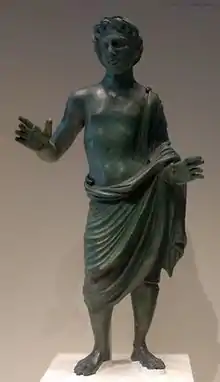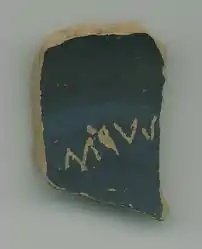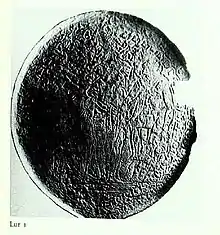Lur (deity)
Lur (Lurs, Luridus, Lurmitla) is an Etruscan deity with not much known history. Lurs does not have many depictions but the ones that have been found show the deity as a male. He has been noted to be associated with a prophetic nature, while also bearing oracular and martial characteristics. He has been linked to another deity by the name of Laran, which suggest is where Lur derives his name from. The context of the name has been associated with darkness and the underworld. A fifth century vase found near a sanctuary in Sans Giovenale reads an inscription that translates: "I am Lurs, that of Laran."[1] Another inscription has been found with the spelling of his name as lartla, noting relations to a Lar, which gives a label to Lur that describes features of protection.[2]

Archaeological Evidence

There is not much information about Lur except from the various evidence found in differing areas. In Corchiano, a candelabrum dating around 400-350 BCE was found with an inscription in dedication to Lur. A bucchero chalice founded by a small shrine near a bridge in San Giovenale does not specifically have inscribed but laruniθla, again, relating Lur to other gods with similar name epithets. A bronze sheet from Perugia reads a translation "dedicated to Lvrmita", suggesting the gods' oracular characteristic. In addition, a bronze statuette possibly from Orvieto features a man, perhaps Vel Matunas, given the inscription on the cloak. The statuette has another votive inscription that translates to "precious/sacred gift to Lur", also contributing to his oracular nature.[3]

Lur has also been mentioned on two lead tablets, one from Magliano and another from Santa Marinella. The latter shows a connection to Tinia and reinforces this relation with other findings in Bolsena inscribed with lurs near two Tinia altars.[2] However, the most prominent evidence discovered concerning Lur is a bronze mirror from Vulci.[4] The mirror is an extension of Lurs relationship with Tinia. In the Lexicon Iconographicum Mythologiae Classicae, H.L Stoltenberg describes the scene present with three figures, Tinia, Lur, and an unknown young man. Tinia is in the middle, identifiable by the lightning bolt. He is wearing a chiton and looking to his right with his right arm raised. The unknown young man sits, appearing to be listening to whatever Tinia might be saying. To the left of the mirror, and Tinias right, sits Lur. He is naked except for a cloak, which is only noticeable from the seal around his neck. His head is thrown back, hair frizzled, and mouth partially open. He carries a sword in his right hand and his left is gesturing towards Tinia. A head coming from the clouds is also seen and has been implied to be delivering a message to Lur.[5] With the combinations of Lurs behavior and gestures, the mirror amplifies a prophetic deity.
Cult
The numerous candelabra founded with Lur inscriptions suggest the object was notable as an offering to the god. An excavation at a sanctuary in Cetamura where a shard with an inscribed Lurs was found, likewise pieces of iron founded fit together to indicate potentially a candelabrum. The bronze Vel Matunas statuette again enforces the cult of Lur. In Gravisca, by the Sacellum Alpha, a miniature shrine, an impasto bowl inscribed with Lur was found. Additionally, a bronze strip from Perugia, as well as a small altar in Vulci both including dedications to lurmitla. The gods name furthermore, is including on the Piacenza liver twice. Scholars have debated with the evidence at hand what exactly the deity Lur oversees. Archaeologist Giovanni Colonna asserts a dark and underworld type of god, while D.F Maras thought of him as more of a warlike and prophetic god. Contrastingly, L. Bouke Van der Meer labels Lur as having the combined qualities.[6]
References
Notes
- Gleba & Becker 2008, pp. 217-227.
- Maras 2009.
- Getty 2002.
- Boardman 1981.
- De Grummond 2010.
- De Grummond 2009.
Bibliography
- Maras, Daniele Federico (2009). Il dono votivo, gli dei e il sacro nelle iscrizioni etrusche di culto. Rome: Fabrizio Serra.
- Boardman, John (1981). Lexicon iconographicum mythologiae classicae. Artemis Verlag.
- Gentili, M. D.; Maneschi, L., eds. (2014). "The cult of Lur: Prophecy and Human Sacrifice?". Studi e ricerche a Tarquinia e in Etruria: Atti del simposio internazionale in ricordo di Francesca Romana Serra Ridgway, Tarquinia 24 – 25 settembre 2010. Rome: Fabrizio Serra. pp. 141–52.
- J. Paul Getty Trust (2002). The J. Paul Getty Museum handbook of the antiquities collection. Los Angeles: Getty Publications.
- Gleba, Margarita; Becker, Hilary, eds. (2008). Votives, Places and Rituals in Etruscan Religion. Leiden: Brill.
External links
 Media related to Lur (deity) at Wikimedia Commons
Media related to Lur (deity) at Wikimedia Commons